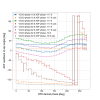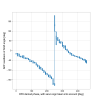Following alog 83343 (transmission VS AOI of a mirror that's supposed to be O3 ZM2), Rahul and I did a similar measurement for the old ZM1 for P-pol at 1064nm. Unlike "ZM2 optic", this one looks good.
Currently, proposed layout for POPX TT looks to have the AOI between 30 and 35 deg, and an alternate proposal is somewhat larger than that but smaller than 45 deg. Either way this old ZM1 optic will work.
| AOI (deg) |
power in transmission [W] |
background [W] |
trans/input |
| 1.4 |
203m |
ignore |
70% |
| 21.4 |
12.79m |
ignore |
4.4% |
| 25.4 |
0.624m |
ignore |
0.22% |
| 30.4 |
33.5u |
0.65u |
110 ppm |
| 35.4 |
9.6u |
0.7u |
31 ppm |
| 40.4 |
5.9u |
0.6u |
18 ppm |
| 45.4 |
1.7u |
0.5u |
4 ppm |
The first two attachments show the experimental setup. The entire TT assembly was put on a rotational stage. The TT suspension was locked during the measurement.
Before and after the measurements, the power of the beam impinging ZM1 was 293mW and 289mW respectively, so I used 2.9e-1W as the input.
AOI close to but not quite retro-reflection (our reference point) was estimated to be ~1.4deg by measuring the distance (~1+-1/8") between the incoming and the reflected beam ~21" away from the mirror surface: (1+-1/8)/21/2 * 180/pi = 1.4+-0.2 deg. (The reason why it's not set to zero+-0.2deg is because of silly mechanical interference we didn't bother to fix.)
At 45.4deg AOI, the beam might have been very close to the back of (or even getting clipped by) the adjustment screw for the eddy current damping magnet. I wasn't able to see the beam (1.7uW of blob is hard to see for anybody) so it's unclear. At least the beam position on the HR surface looked OK, so if the beam is clipped by the adjustment screw it might be unnecessarily long. I'll have another look with IR sensitive camera on Monday.














Looks like this was just an instance of the 2-hour timer in H1_MANAGER for not reaching observing expiring just minutes before reaching low noise. There were about 3hr15min between the last lockloss and getting back to NLN, but that timer restarts after an initial alignment is ran (which had happened), and it took 2hr2min to reach NLN due to a couple locklosses on the way up, so no actual issue here.